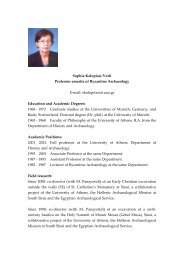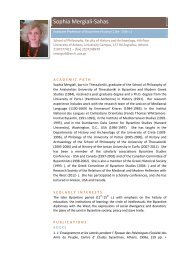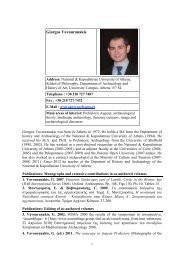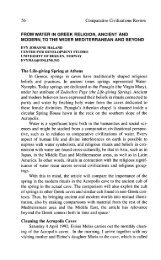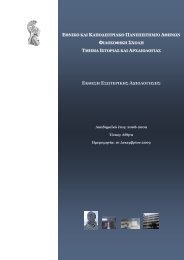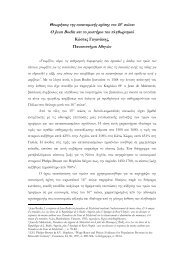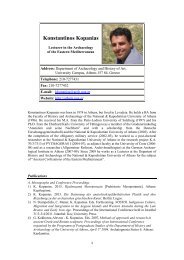The Dormition of the Virgin Mary on the Island of Tinos: A ...
The Dormition of the Virgin Mary on the Island of Tinos: A ...
The Dormition of the Virgin Mary on the Island of Tinos: A ...
Create successful ePaper yourself
Turn your PDF publications into a flip-book with our unique Google optimized e-Paper software.
92 JOURNAL OF RELIGIOUS HISTORY<br />
is followed by her burial or <str<strong>on</strong>g>the</str<strong>on</strong>g> “9th day’s ritual <str<strong>on</strong>g>of</str<strong>on</strong>g> <str<strong>on</strong>g>the</str<strong>on</strong>g> Panagia” <strong>on</strong> 23 August,<br />
thus reflecting ordinary death rituals and <str<strong>on</strong>g>the</str<strong>on</strong>g> following memorial service. In<br />
Greece, <str<strong>on</strong>g>the</str<strong>on</strong>g> transiti<strong>on</strong> to <str<strong>on</strong>g>the</str<strong>on</strong>g> fertile and healing period starts when, according to<br />
popular belief, <str<strong>on</strong>g>the</str<strong>on</strong>g> Panagia descended into <str<strong>on</strong>g>the</str<strong>on</strong>g> underworld, and c<strong>on</strong>sequently<br />
ensures <str<strong>on</strong>g>the</str<strong>on</strong>g> future fertility in agreement with <str<strong>on</strong>g>the</str<strong>on</strong>g> divine underworld. 7 One<br />
might also say that she falls asleep before she is reborn in September, paralleling<br />
<str<strong>on</strong>g>the</str<strong>on</strong>g> earth that sinks to rest after harvest and is renewed in <str<strong>on</strong>g>the</str<strong>on</strong>g> autumn,<br />
since <str<strong>on</strong>g>the</str<strong>on</strong>g>re is a corresp<strong>on</strong>dence between <str<strong>on</strong>g>the</str<strong>on</strong>g> earth and <str<strong>on</strong>g>the</str<strong>on</strong>g> Panagia as shown in<br />
her biography and <str<strong>on</strong>g>the</str<strong>on</strong>g> important phases <str<strong>on</strong>g>of</str<strong>on</strong>g> <str<strong>on</strong>g>the</str<strong>on</strong>g> agricultural year, from <str<strong>on</strong>g>the</str<strong>on</strong>g><br />
sowing to <str<strong>on</strong>g>the</str<strong>on</strong>g> harvest.<br />
<str<strong>on</strong>g>The</str<strong>on</strong>g> day <str<strong>on</strong>g>of</str<strong>on</strong>g> 15 August is celebrated with special reverence all over Greece<br />
and pilgrimages are made to <str<strong>on</strong>g>the</str<strong>on</strong>g> greatest shrine <str<strong>on</strong>g>of</str<strong>on</strong>g> Greek Orthodoxy, <str<strong>on</strong>g>the</str<strong>on</strong>g><br />
Aegean island <str<strong>on</strong>g>of</str<strong>on</strong>g> <strong>Tinos</strong>. This is <str<strong>on</strong>g>the</str<strong>on</strong>g> most important festival <strong>on</strong> <strong>Tinos</strong> today for<br />
several reas<strong>on</strong>s.<br />
<str<strong>on</strong>g>The</str<strong>on</strong>g> Sanctuary <strong>on</strong> <strong>Tinos</strong><br />
In 1823 <str<strong>on</strong>g>the</str<strong>on</strong>g> inhabitants <str<strong>on</strong>g>of</str<strong>on</strong>g> <strong>Tinos</strong> found <str<strong>on</strong>g>the</str<strong>on</strong>g> miraculous holy ic<strong>on</strong> (image) <str<strong>on</strong>g>of</str<strong>on</strong>g> <str<strong>on</strong>g>the</str<strong>on</strong>g><br />
Annunciati<strong>on</strong> (Euangelismos) <str<strong>on</strong>g>of</str<strong>on</strong>g> <str<strong>on</strong>g>the</str<strong>on</strong>g> Panagia (Megalocharē, megalo: great,<br />
charē: grace, i.e., <str<strong>on</strong>g>the</str<strong>on</strong>g> Blessed <str<strong>on</strong>g>Virgin</str<strong>on</strong>g>). 8 According to traditi<strong>on</strong>, an islander —<br />
<str<strong>on</strong>g>the</str<strong>on</strong>g> nun Pelagia — had repeated visi<strong>on</strong>s <str<strong>on</strong>g>of</str<strong>on</strong>g> <str<strong>on</strong>g>the</str<strong>on</strong>g> Panagia, who ordered her to<br />
inform <str<strong>on</strong>g>the</str<strong>on</strong>g> elders to start excavati<strong>on</strong>s for her ic<strong>on</strong> in an uncultivated field, and<br />
to build her “house” (church) <strong>on</strong> that site. On 30 January 1823, <str<strong>on</strong>g>the</str<strong>on</strong>g> ic<strong>on</strong> was<br />
unear<str<strong>on</strong>g>the</str<strong>on</strong>g>d in that field where it had been buried 850 years earlier in <str<strong>on</strong>g>the</str<strong>on</strong>g> 10th<br />
century CE, when a church built <strong>on</strong> <str<strong>on</strong>g>the</str<strong>on</strong>g> ruins <str<strong>on</strong>g>of</str<strong>on</strong>g> <str<strong>on</strong>g>the</str<strong>on</strong>g> pagan temple <str<strong>on</strong>g>of</str<strong>on</strong>g> Di<strong>on</strong>ysos<br />
was destroyed and burned down by <str<strong>on</strong>g>the</str<strong>on</strong>g> Saracens. Two years before <str<strong>on</strong>g>the</str<strong>on</strong>g> ic<strong>on</strong> was<br />
found, <str<strong>on</strong>g>the</str<strong>on</strong>g> great Greek War <str<strong>on</strong>g>of</str<strong>on</strong>g> Independence (1821) broke out. <str<strong>on</strong>g>The</str<strong>on</strong>g> finding <str<strong>on</strong>g>of</str<strong>on</strong>g><br />
<str<strong>on</strong>g>the</str<strong>on</strong>g> ic<strong>on</strong>, <str<strong>on</strong>g>the</str<strong>on</strong>g> c<strong>on</strong>structi<strong>on</strong> <str<strong>on</strong>g>of</str<strong>on</strong>g> <str<strong>on</strong>g>the</str<strong>on</strong>g> church <str<strong>on</strong>g>of</str<strong>on</strong>g> <str<strong>on</strong>g>the</str<strong>on</strong>g> Panagia Euangelistria, <str<strong>on</strong>g>the</str<strong>on</strong>g><br />
7. This might be problematic from a <str<strong>on</strong>g>the</str<strong>on</strong>g>ological point <str<strong>on</strong>g>of</str<strong>on</strong>g> view; however, as an historian, not as<br />
a <str<strong>on</strong>g>the</str<strong>on</strong>g>ologian, I am merely pointing out that <str<strong>on</strong>g>the</str<strong>on</strong>g> survival <str<strong>on</strong>g>of</str<strong>on</strong>g> values and beliefs, even though new<br />
normative religi<strong>on</strong>s have been introduced, and <str<strong>on</strong>g>the</str<strong>on</strong>g> close relati<strong>on</strong>ship between <str<strong>on</strong>g>the</str<strong>on</strong>g> <str<strong>on</strong>g>of</str<strong>on</strong>g>ficial Orthodox<br />
religi<strong>on</strong> and popular religi<strong>on</strong> (particularly in rural parts <str<strong>on</strong>g>of</str<strong>on</strong>g> Greece) is a well-known fact which is<br />
also embedded in <str<strong>on</strong>g>the</str<strong>on</strong>g> practical celebrati<strong>on</strong> <str<strong>on</strong>g>of</str<strong>on</strong>g> Orthodox festivals (see n. 45 also). This has been<br />
illustrated by several o<str<strong>on</strong>g>the</str<strong>on</strong>g>r researchers, see Kyriakidou-Nestoros, Oi 12 Mēnes; E. Psychogiou,<br />
“Maurēgē” kai Elenē: Teletourgies Thanatou kai Anagennēsēs, Dēmosieumata tou Kentrou<br />
Ereunēs tēs Ellēnikēs Laographias 24 (A<str<strong>on</strong>g>the</str<strong>on</strong>g>ns: Academy <str<strong>on</strong>g>of</str<strong>on</strong>g> A<str<strong>on</strong>g>the</str<strong>on</strong>g>ns, 2008); Håland, “Rituals <str<strong>on</strong>g>of</str<strong>on</strong>g><br />
Magical Rain-Making in Modern and Ancient Greece”; Håland, Greek Festivals, Modern and<br />
Ancient, ch. 3; Håland, “<str<strong>on</strong>g>The</str<strong>on</strong>g> Ritual Year as a Woman’s Life.” C. Stewart, Dem<strong>on</strong>s and <str<strong>on</strong>g>the</str<strong>on</strong>g> Devil:<br />
Moral Imaginati<strong>on</strong> in Modern Greek Culture (Princet<strong>on</strong>: Princet<strong>on</strong> University Press, 1991), argues<br />
against <str<strong>on</strong>g>the</str<strong>on</strong>g> c<strong>on</strong>ceptual separati<strong>on</strong> <str<strong>on</strong>g>of</str<strong>on</strong>g> church doctrine and folk practice; see also Du Boulay,<br />
Cosmos, Life, and Liturgy, for c<strong>on</strong>tinuities.<br />
8. According to D. N. Stavropolos, Oxford Greek—English Learner’s Dicti<strong>on</strong>ary (Oxford:<br />
Oxford University Press, 1991), 532. However, literally, <str<strong>on</strong>g>the</str<strong>on</strong>g> word “virgin” is not included in<br />
Megalocharē, so perhaps “greatly blessed” or “exceedingly graced” might be better translati<strong>on</strong>s.<br />
O<str<strong>on</strong>g>the</str<strong>on</strong>g>r inc<strong>on</strong>sistencies in <str<strong>on</strong>g>the</str<strong>on</strong>g> translati<strong>on</strong> <str<strong>on</strong>g>of</str<strong>on</strong>g> <str<strong>on</strong>g>the</str<strong>on</strong>g> Panagia, etc. are found in <str<strong>on</strong>g>the</str<strong>on</strong>g> <str<strong>on</strong>g>of</str<strong>on</strong>g>ficial English<br />
translati<strong>on</strong> <str<strong>on</strong>g>of</str<strong>on</strong>g> <str<strong>on</strong>g>the</str<strong>on</strong>g> pamphlet distributed to <str<strong>on</strong>g>the</str<strong>on</strong>g> pilgrims at <strong>Tinos</strong>, E. A. Foskolos, Perigraphē tēs<br />
Eureseōs tēs Thaumatourgou Agias Eik<strong>on</strong>as tēs Euangelistrias stēnTēno kata to etos 1823. Skopoi<br />
kai drastēriotētes tou Ierou Idrymatos (<strong>Tinos</strong>: Panellēniou Ierou Idrymatos Euangelistrias Tēnou,<br />
1996, orig. 1968) (English versi<strong>on</strong> from 1991, tr. C. Meihanetsidis). <str<strong>on</strong>g>The</str<strong>on</strong>g> English versi<strong>on</strong>(s) <str<strong>on</strong>g>of</str<strong>on</strong>g> <str<strong>on</strong>g>the</str<strong>on</strong>g><br />
pamphlet, for example, never translate Euangelistria with <str<strong>on</strong>g>the</str<strong>on</strong>g> Panagia <str<strong>on</strong>g>of</str<strong>on</strong>g> <str<strong>on</strong>g>the</str<strong>on</strong>g> Annunciati<strong>on</strong> or <str<strong>on</strong>g>the</str<strong>on</strong>g><br />
annunciated, but clearly states, “<str<strong>on</strong>g>The</str<strong>on</strong>g> Church <str<strong>on</strong>g>of</str<strong>on</strong>g> <str<strong>on</strong>g>the</str<strong>on</strong>g> Annunciati<strong>on</strong> (Euangelistria)” <strong>on</strong> page 11 (by<br />
T. D. Silvestros) <str<strong>on</strong>g>of</str<strong>on</strong>g> <str<strong>on</strong>g>the</str<strong>on</strong>g> 2004 versi<strong>on</strong>; cf. also infra. In general, Greek scholars recommend<br />
Euangelistria not be translated.<br />
© 2012 <str<strong>on</strong>g>The</str<strong>on</strong>g> Author<br />
Journal <str<strong>on</strong>g>of</str<strong>on</strong>g> Religious History © 2012 Religious History Associati<strong>on</strong>



